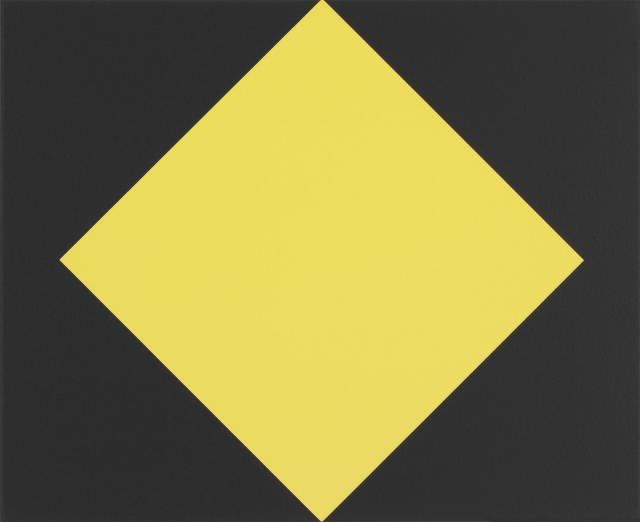The paintings of Francis Baudevin are impeccable works of art. Although each is done using a brush, there is not a drip, mistake or trace that can be made out beneath the smooth texture of the pigment covering the canvas.
Adhering to a self-imposed protocol from the 1980s that has remained unchanged since, the artist works by sampling graphic motifs, often from advertising, which he redeploys in paint. Baudevin’s intervention lies solely in the selection of source images and their modification by subtraction (of any typographic signs) and enlargement (of the format). His art is about minimum gesture and light intervention, though it is an intervention that projects the motifs selected by Baudevin into another field of meaning, or rather non-meaning.
When he works the logo of the transportation, courier and delivery service UPS, for example, he keeps the exact same colours, arrangement and relationships between forms as the original. Without the text that identifies the brand, the composition becomes a painting, a work of art that takes its place in a history of pictorial experiments theorised by the abstract painters who have gone before Baudevin.
Even though he recycles motifs coming from the world of consumerism, he is indeed working with the rich legacy of 20th-century abstraction, and situates his practice in an inspiring dialogue with the history of nonfigurative art, from Kasimir Malevitch’s black square to the 1930s mathematical art of Zurich, to the recent Neo-Geo trend. His field of formal exploration is the purified elementary geometry coming from Concrete Painting which, when transformed by graphic effects, takes on a dimension that is suddenly less radical and austere, whilst remaining a means for questioning the cultural project of modernity.
Baudevin is not pursuing the objectives of modern artists like Wassily Kandinsky or Piet Mondrian, who associated spiritual and mystical dimensions with the abstract approach; he leads the viewer towards other visual and physical experiences that draw on different cultural domains. His work reminds us then that an artistic approach is rooted in a relationship to the world that often exceeds the strict field of art history.
Adhering to a self-imposed protocol from the 1980s that has remained unchanged since, the artist works by sampling graphic motifs, often from advertising, which he redeploys in paint. Baudevin’s intervention lies solely in the selection of source images and their modification by subtraction (of any typographic signs) and enlargement (of the format). His art is about minimum gesture and light intervention, though it is an intervention that projects the motifs selected by Baudevin into another field of meaning, or rather non-meaning.
When he works the logo of the transportation, courier and delivery service UPS, for example, he keeps the exact same colours, arrangement and relationships between forms as the original. Without the text that identifies the brand, the composition becomes a painting, a work of art that takes its place in a history of pictorial experiments theorised by the abstract painters who have gone before Baudevin.
Even though he recycles motifs coming from the world of consumerism, he is indeed working with the rich legacy of 20th-century abstraction, and situates his practice in an inspiring dialogue with the history of nonfigurative art, from Kasimir Malevitch’s black square to the 1930s mathematical art of Zurich, to the recent Neo-Geo trend. His field of formal exploration is the purified elementary geometry coming from Concrete Painting which, when transformed by graphic effects, takes on a dimension that is suddenly less radical and austere, whilst remaining a means for questioning the cultural project of modernity.
Baudevin is not pursuing the objectives of modern artists like Wassily Kandinsky or Piet Mondrian, who associated spiritual and mystical dimensions with the abstract approach; he leads the viewer towards other visual and physical experiences that draw on different cultural domains. His work reminds us then that an artistic approach is rooted in a relationship to the world that often exceeds the strict field of art history.
